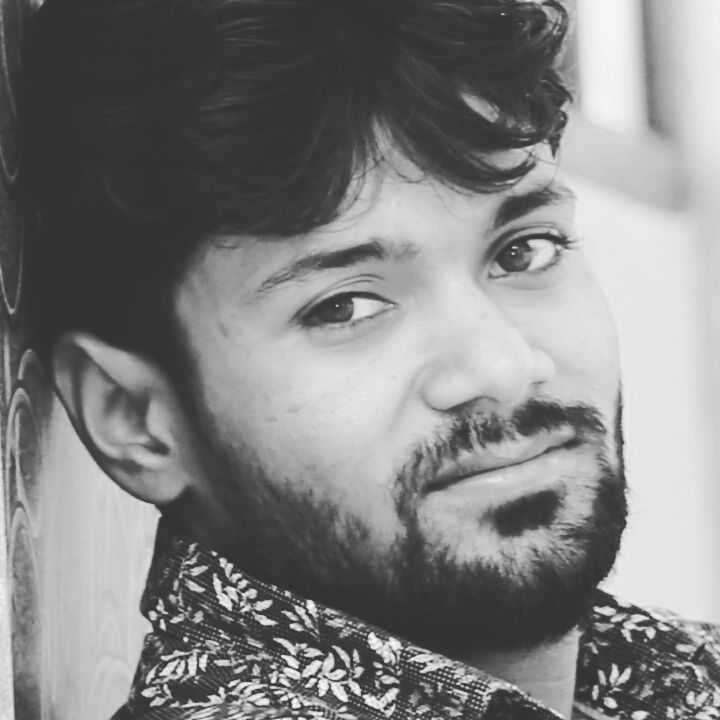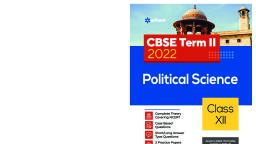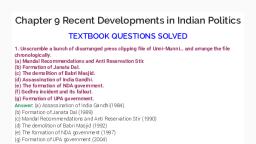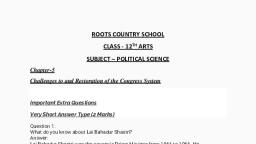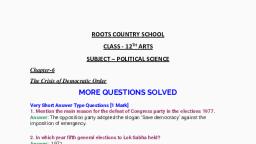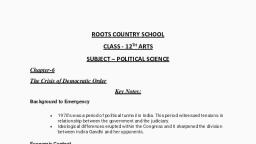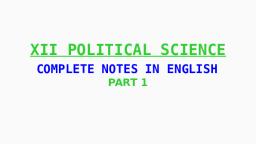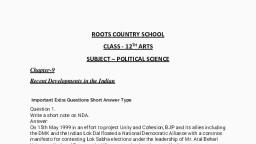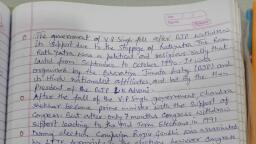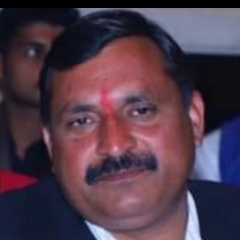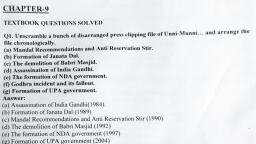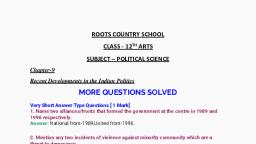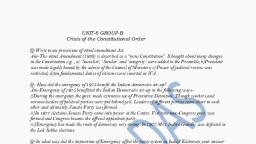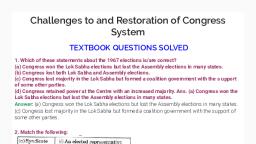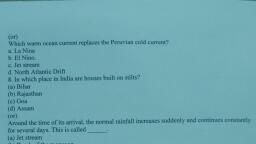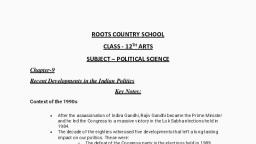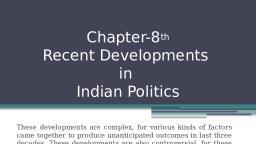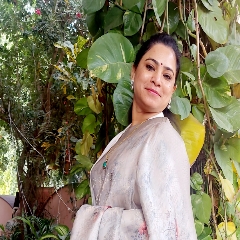Page 1 :
Chapter 6 The Crisis of Democratic Order, TEXTBOOK QUESTIONS SOLVED, l. State whether the following statements regarding the Emergency are correct or incorrect., (a) It was declared in 1975 by Indira Gandhi., (b) It led to the suspension of all fundamental rights., (c) It was proclaimed due to the deteriorating economic conditions., (d) Many Opposition leaders were arrested during the emergency., (e) CPI supported the proclamation of the Emergency., Answer: (a) Correct, (b) Correct, (c) Wrong,, (d) Correct, (e) Correct., 2. Find the odd one out in the context of proclamation of Emergency., (a) The call for ‘Total Revolution’., (b) The Railway Strike of 1974, (c) The Naxalite Movement, (d) The Allahabad High Court verdict, (e) The findings of the Shah Commission Report, Answer: (c) The Naxalite Movement, 3. Match the following:, , Answer: (a)-(iii), (b)-(i), (c)-(ii), (d)-(iv)., 4. What were the reasons which led to the mid-term elections in 1980?, Answer: 1. Janata party lacked direction, leadership and a common programme., 2. Janata party government could not bring a fundamental change in policies pursued by Congress., 3. There was a split in Janata Party and the government led by Morarji Desai which lost its majority, in less than 18 months., 4. Charan Singh government was formed due to support of Congress party which later decided to, withdraw its support resulting resignation of Charan Singh government within four months., 5. All the above mentioned reasons led midterm elections of 1980, which defeated Janata Party and, again Congress led by Indira Gandhi came back to power by winning 353 seats., 5. The Shah Commission was appointed in 1977 by the Janata Party Government. Why was it, appointed and what were its findings?, Answer: The Shah commission was appointed in May 1977 by Janata Party government which was, headed by J.C. Shah, retired chief justice of Supreme Court of India to look into the matters of:, 1. Allegations of abuse of authority, excesses and malpractices as well as actions taken in the name, of emergency proclaimed on 25 June 1975., Material Downloaded from SUPERCOP
Page 2 :
2. The Commission performed to examine various evidences to give testimonies even including, Indira Gandhi to appear before Commission, but she refused to answer any questions., Findings of Shah Commission:, (a) It found many ‘excesses’ committed during Emergency., (b) Under preventive detention laws nearly one lakh eleven thousand people were arrested., (c) Press censorship took place without any proper legal sanctions., (d) Even general manager of Delhi Power Supply Corporation received verbal orders from the officers, of the Lt. Governor of Delhi to cut electricity to all newspapers press at 2 a.m. on 26 June 1975., 6. What reasons did the Government give for declaring a National Emergency in 1975?, Answer: Emergency was proclaimed in response to petition filed by Raj Narain to declare Indira, Gandhi’s election invalid., (i) On June 25, 1975, the government declared the threat of internal disturbances to invoke Article, 352 of constitution., (ii) Article 352 can declare emergency on ground of either internal or external disturbances., (iii) The government decided a grave crisis to be arisen to proclaim emergency to bring law and, order, restore efficiency and implement pro-poor welfare programmes., (iv) The President Fakhruddin Adi Ahmad proclaimed emergency which became the most, controversial episode in Indian Politics., 7. The 1977 elections for the first time saw the Opposition coming into power at the Centre. What, would you consider as the reasons for this development?, Answer: The 1977 elections were evolved as a shock to everyone as Congress party was defeated, for the very first time and opposition party came into power:, 1. The opposition adopted the slogan ‘Save democracy’ against imposition of emergency earlier., 2. The opposition campaigned non- democratic character of rule which provided various excesses., 3. The opposition party highlighted the preventive detention and press censorship to favour public, opinion., 4. Janata Party also ensured not to divide non-Congress votes., 5. Middle section of north India was moving away from Congress for whom Janata Party became a, platform., 6. Hence, elections of 1977 emerged many other factors instead about emergency only., 8. Discuss the effects of Emergency on the following aspects of our polity., (a) Effects on civil liberties for citizens., (b) Impact on relationship between the Executive and Judiciary., (c) Functioning of Mass Media., (d) Working of Police and Bureaucracy., Answer: (a) Effects on Civil Liberties for Citizens:, 1. The government made large scale arrests under preventive detention., 2. Arrested political persons could not challenge arrest even under Habeas Corpus petition., 3. Despite of filing many petitions government claimed it not to be necessary to be informed on, grounds to arrested persons., 4. In April 1976, finally it was proved that the government could take away citizen’s right to life and, liberty by overruling of high courts under supreme court and accept government’s plea., (b) Impact on Relationship between the Executive and Judiciary:, 1. The Parliament brought in many new changes in Constitution which made an amendment, declaring that elections of Prime Minister, President and Vice¬President could not be challenged in, the court., Material Downloaded from SUPERCOP
Page 3 :
2. The forty-second amendment (42nd) was also passed to bring a series of changes in constitution, like duration of legislatures, elections can be postponed by one, year during an emergency., (c) Functioning of Mass Media:, 1. Press censorship took place which banned freedom of press and newspapers w7ere supposed to, prior approval before they, publish any material i.e. RSS and Janata Island were banned., 2. Protests, strikes and public agitations were also banned., 3. Various fundamental rights were also suspended including even Right to move to court for, restoration of Fundamental Rights., 4. Kannada writer Shivarama Karanth awarded with Padma Bhushan and Hindi writer, Fanishwarnath Tlenu with Padmashri returned their awards in protest against suspension of, democracy., 5. Newspapers mainly Indian Express, and the statesman protested against censorship by leaving, blank spaces where news items were censored., (d) Working of Police and Bureaucracy:, Refer Part (a) + (b) of the same question., 9. In what way did the imposition of Emergency affect the party system in India? Elaborate your, answer with examples., Answer: 1. Due to absolute majority to party in power, leadership even dared to suspend democratic, process., 2. The constitution makers presumed to be abide by laws and democratic orders, hence, wide and, open ended powers were given to the government during emergency., 3. A tension and differences arose between institution based democracy and democracy based on, spontaneous popular participation., 4. It was attributed to incapability of party system to incorporate aspirations of the people., 5. For the first time, opposition parties came together to form a new party ‘Janata Party’ not to, divide the non-Congress votes., 6. 1977 elections brought an end to one party dominance and created coalition government., 10. Read the passage and answer the questions below:, “Indian democracy was never so close to a two-party system as it was during the 1977 elections., However, the next few years saw a complete change. Soon after its defeat, the Indian National, Congress split into two groups, The Janata Party also went, through major convulsions David, Butler, Ashok Lahiri and Prannoy Roy., —Partha Chatterjee, (a) What made the party system in India look like a two-party system in 1977?, (b) Many more than two parties existed in 1977. Why then are the authors describing this period, as close to a two-party system?, (c) What caused splits in Congress and the Janata Party?, Answer: (a) The imposition of emergency in 1977 and political crisis made the party system in India, look like a two-party system., (b) Two parties existed in 1977 were Congress and non-Congress parties to be described as close to, two party system because it ended the one party dominance and emerged Janata Party, umbrella of, non¬Congress parties., (c) Split in Congress: Congress splitted on the issues of presidential elections in 1969. Split in, , Material Downloaded from SUPERCOP
Page 4 :
Janata Party: On tensions among three leaders Morarji Desai, Charan Singh and Jagjivan Ram for, leadership in 1979., , MORE QUESTIONS SOLVED, Very Short Answer Type Questions [1 Mark], 1. Mention the main reason for the defeat of Congress party in the elections 1977., Answer: The opposition party adopted the slogan ‘Save democracy’ against the imposition of, emergency., 2. In which year fifth general elections to Lok Sabha held?, Answer: 1971., 3. Name the political party which came to power at centre in 1977., Answer: Janata Party, 4. In January 1974, Students of Gujarat started an agitation against which two major problems?, Answer: 1. Rising prices of food grains, cooking oil and other essential commodities., 2. Corruption in high places., 5. Who was Charu Majumdar?, Answer: Charu Majumdar was a communist revolutionary and the leader of Naxalbari uprising. He, founded the Communist Party of India (Marxist Leninist)., 6. Name the president who proclaimed emergency in 1975 in India., Answer. President Fakhruddin Ali Ahmad at midnight on 25 June 1975., 7. Who introduced Twenty Point Programme and Why?, Answer: Congress government led by Indira Gandhi introduced ‘Twenty Point Programme’ to, maintain law and order and to restored efficiency including land reforms, eradication of bonded, labour, land redistribution, workers participation in management etc., 8. Who became the symbol of restoration of democracy?, Answer: Jayaprakash Narayan, leader of Janata Party., 9. Mention the Historic decision given by the court in famous Kesavananda Bharati Case., Answer: That there are some basic features of constitution not to be amended by parliament at all., It led to a crisis between the government and judiciary., 10. What was the controversy regarding the appointment of the chief justice A.N. Ray in 1973?, Answer: It became political controversial because in this appointment the government set aside the, seniority of three judges who had given ruling against the stand of government., 11. Why did Congress win in Southern states?, Answer: 1. The impact of emergency was not felt equally in all the states., 2. The forced relocation and dis¬placements, the forced sterilisations were mostly concentrated in, the northern states., Material Downloaded from SUPERCOP
Page 5 :
12. What do you mean by Preventive Detention?, Answer: In Preventive Detention Act, people are arrested and detained on the apprehension to, commit any offence in future and government made large scale arrests under this during, emergency., Very Short Answer Type Questions [2 Marks], 1. What factors led to crisis of democratic order in Indian Politics?, Answer: 1. Emergence of Indira Gandhi with a lot of popularity., 2. Party competitions had been created., 3. Relation between the government and judiciary had become tense., 2. Mention the factors which led Naxalite movement in backward states., Answer: 1. Forced labour, 2. Exploitation by moneylenders, 3. Exploitation of resources by outsiders., 3. What was Shah Commission of inquiry?, How did government react to it? “, Answer: The Shah commission was appointed in May 1977 by Janata Party government headed by, S.C. Shah, retired chief justice of Supreme Court of India to look into the matter of:, 1. Allegations of abuse of authority., 2. Excesses and malpractices., 3. Actions taken in the name of emergency proclaimed on 25 June 1975., The government appeared before commission against various evidences but she refused to answer, any question., 4. Describe any two outcomes of Naxalite Movement., Answer: The ‘Naxalites’ were the Marxist and Leninist Agricultural workers of Andhra Pradesh, West, Bengal, Bihar and adjoining areas who organised massive agitations against economic injustice and, inequality and demanded redistribution of land to cultivators., 5. Mention circumstances to be characterised for imposition of emergency?, Answer: 1. Emergence of Indira Gandhi., 2. Power Politics became personalised and governmental authority was converted into, personalization., 3. Bitter party competition., 4. Tense relations between the government and judiciary., 6. Who organised the first nationwide Satyagraha and Why?, Answer: It was organised by Jayaprakash Narayan for Indira Gandhi’s resignation, he appealed to, people not to obey illegal and immoral orders by a massive demonstration on 25 June 1975. All, these changed the political mood of the country against Congress., Short Answer Type Questions [4 Marks], 1. Explain the reasons for students movement of 1974 in Bihar and the role played by, Jayaprakash Narayan in this movement., Answer: Reasons for Student’s Movement of 1974:, Students organised movement against:, 1. Rising prices of food grains, cooking oil and other essential commodities., Material Downloaded from SUPERCOP
Page 6 :
2. Corruption in high places., Assess Role played by Jai Prakash Narayan:, Satyagraha was organised by Jayaprakash Narayan for Indira Gandhi’s resignation, he appealed to, people not to obey illegal and immoral orders by a massive demonstration on 25 June 1975. All, these changed the political mood of the country against Congress., 2. Evaluate the consequences of declaration of emergency in 1975?, Answer: 1. It effected civil liberties of peoples i.e., in April11976 it was proved that the, government could take away citizens’ right to life and liberty by overruling of high courts under, supreme courts and accepted government’s plea., 2. The forth-second Amendment was also passed to bring a series of changes in constitution., 3. It affected the functioning of mass media also as press censorship took place which banned, freedom of press and newspapers, which were supposed to prior approval before they publish any, material., 4. Despite of filing many petitions government claimed it not to be necessary to be informed the, grounds to arrested persons., 3. Explain any two lessons learnt from emergency imposed in 1975., Answer: The emergency brought out weaknesses and strengths both to India’s democracy:, 1. First lesson was felt that it was extremely difficult to do away with democracy in India., 2. Secondly, it amended that internal emergency could be proclaimed only on the grounds of armed, rebellion, on the advice to the president to proclaim emergency must be given in writing by council, of ministers., 3. Thirdly, emergency made everyone more aware of civil liberties as well as courts also took an, active role in protecting civil liberties of individuals., 4. Examine the legacy of emergency of 1975 in India., Answer: The legacy of emergency was felt in every, sphere of people’s life and politics:, 1. Between the elections of 1977 and 1980, Congress identified itself with particular ideology,, claiming to be only socialist and pro-poor party., 2. The concept of non-Congression was created among oppositions parties., 3. The issues of welfare of backward classes began to dominate politics i. e. northern states elected, non¬Congress leaders of backward class since 1977., 4. This period of emergency saw the period of constitutional crisis to loose its origin in, constitutional battle over jurisdiction of parliament and judiciary., 5. This period created political crisis also as the party in power enjoyed absolute majority, still, decided to suspend the democratic process., 6. The emergency tensed between institution based democracy and democracy based on, spontaneous popular participation for which party system was to be blamed., 5. Why is emergency and period around it known as the period of constitutional crisis? Explain., Answer: 1. The Parliament brought in many new changes in constitution which made an, amendment declaring that elections of Prime Minister, President and Vice President could not be, challenged in the court., 2. The forty second amendment was also passed to bring a series of changes in constitution like, duration of legislatures, elections can be postponed by one year during emergency., Material Downloaded from SUPERCOP
Page 7 :
6. How far do you agree that the government had misused its emergency powers during 1975-77?, Explain., Answer: No, the government hence misused its ‘Emergency Powers’. But it said that it wanted to, use the emergency:, 1. To bring law and order into society., 2. To restore efficiency into administra¬tion and system., 3. To implement the pro-poor welfare programmes., 7. How did emergency of 1975 benefit the Indian democratic set up?, Answer: 1. Between the elections of 1977 and 1980, Congress identified itself with particulars, ideology, claiming to be only socialist and pro-poor party., 2. The concept of non-Congressism was created among opposition parties., 3. The issues of welfare of backward class began to dominate politics, i. e. Northern states elected nonCongress leaders of backward class since 1977., 4. The emergency tensed between institution based democracy and democracy based on, spontaneous popular participation for which party system was to be blamed., 8. Describe any four circumstances for proclamation of emergency in 1975., Answer:1. Emergence of Indira Gandhi., 2. Power politics became personalised and governmental authority was converted into, personalization., 3. Bitter party competition., 4. Tensed relations between the government and judiciary., 9. Discuss the role of Jayaprakash Narayan in Bihar movement and national politics., Answer: 1. Loknayak Jayaprakash Narayan from Janata Party was a Marxist of youth, who became, a Gandhian and involved himself in a Bhoodan movement., 2. He led Bihar movement and opposed the emergency., 3. Bihar students invited him and he accepted on the condition of movement to be non-violent and, not to limit only to Bihar territory. Hence, Bihar movement assumed a political character and, national appeal., 4. This movement demanded dismissal of Congress government in Bihar and called for total, revolution in social, economic and political aspects to establish a total democracy., 5. Bandhs, gheraos, strikes were organised in protest. Even employees of railways organised a strike, which threatened to paralyse the country., 6. In 1975, Janata Party led people’s march to parliament to be one of the largest political rallies ever, held in capital., 7. Janata was supported by non¬Congress parties like BJS, socialist, parties etc., which projected JP as an alternative to Indira Gandhi., 10. ‘Emergency was a Blackmark in Indian History’. Comment., Answer: 1. Emergency was declared on the ground of internal disturbances on 25 June 1975 to, invoke Article 352 of constitution., 2. Prime Minister Indira Gandhi recommended to impose emergency to president Fakhruddin Ali, Ahmad., 3. Emergency was one of the most controversial episode which possessed different virus regarding, to impose emergency., 4. Emergency practically suspended the democratic functioning., Material Downloaded from SUPERCOP
Page 8 :
5. ‘Shah Commission’ exposed many excesses committed during emergency., 6. Emergency highlighted some hidden matters over constitutional battle between the parliament, and judiciary., 7. Tensions or conflicts had been arisen between institution based democracy and popular, participation of people., Passage Based Questions [5 Marks], 1. Read the passage given below carefully and answer the questions:, Once an emergency is proclaimed, the federal distribution of powers remains practically, suspended and al 1 t be powc itc, the hands of the union government. Secondly, the government also gets the power to curtail or, restrict all or any of the Fundamental Rights during the emergency. From the wording of the, provisions of the Constitution, it is clear that an Emergency is seen as an extra-iordinary, condition in which normal democratic politics cannot function. Therefore, special powers are, granted to the government., Questions, 1. When was emergency imposed?, 2. Who recommended emergency to be imposed and to whom?, 3. Mention the implications of emergency., Answer:, 1. 25 June 1975., 2. Prime Minister Indira Gandhi recommended to impose emergency to the president Fakhruddin Ali, Ahmad., 3. (i) The federal distribution of powers remains practically suspended., (ii) All the powers are concentrated in the hands of Union government., (iii) The government also gets power to restrict all or any of Fundamental Rights during emergency., 2. Read the passage given below carefully and answer the questions:, There were many acts of dissent and resistance to the Emergency. Many political workers who, were not arrested in the first wave, went ‘underground’ and organised protests against the, government. Newspapers like the Indian Express and the Statesman protested against, censorship by leaving blank spaces where news items had been censored. Magazines like the, Seminar and the Mainstream chose to close down rather than submit to censorship. Many, journalists were arrested for writing against the Emergency. Many underground newsletters and, leaflets were published to bypass censorship. Kannada writer Shivarama Karanth, awarded with, Padma Bhushan, and Hindi writer Fanishwarnath Renu, awarded with Padma Shri, returned their, awards in protest against the suspension of democracy. By and large, though, such open acts of, defiance and resistance were rare., Questions, 1. Why did people began to protest against government?, 2. How did newspapers protest against censorship?, 3. How did writers protest against the emergency?, 4. Which magazines protested against censorship?, Answer:, 1. Against imposition of emergency., 2. Newspaper like Indian Express and the Statesman protested against censorship by leaving blank, spaces where news items had been censored., 3. Kannada writer Shivarama Karanth awarded with Padma Bhushan and Hindi writer, Fanishwarnath Renu awarded with Padma Shri returned their awards in protest against suspension, of democracy., 4. Magazines like ‘Seminar’ and ‘Mainstream’ chose to close down rather than submit to censorship., Material Downloaded from SUPERCOP
Page 9 :
Long Answer Type Questions [6 Marks], 1. Analyse any three lessons learnt from the emergency of 1975., Answer: (i) The emergency of 1975 at once brought out both the weaknesses’ and the strengths of, India’s democracy. Though there are many observers who think that India ceased to be democratic, during the emergency, it is noteworthy that normal democratic functioning resumed within a short, span of time. Thus, one lesson of Emergency is that it is extremely difficult to do away with, democracy in India., (ii) It brought out some ambiguities regarding the emergency provision in the constitution that have, been rectified since. Now ‘internal’ emergency can be proclaimed only on the grounds of ‘armed, rebellion’ and it is necessary that the advice to the President to proclaim emergency must be given, in writing by the Council of Ministers., (iii) The Emergency made everyone aware of the value of civil liberties. The courts, too, have taken, an active role after the emergency in protecting the civil liberties of the individuals. This is in, response to the inability of the judiciary to protect civil liberties effectively during the emergency., Many civil liberties organizations came up after this experience., 2. Examine the three consequences of emergency imposed in 1975., Answer: (a) Effects on Civil Liberties of Citizens:, 1. The government made large scale arrests under preventive detention., 2. Arrested political persons could not challenge arrest even under Habeas Corpus petition., 3. Despite filing many petitions government claimed it not to be necessary to be informed of, grounds to arrested persons., 4. In April 1976, finally it was proved that the government could taken away citizen’s right to life and, liberty by over ruling of high courts under supreme court and accepted government’s plea., (b) Impact on Relationship between Parliament and Judiciary:, 1. The parliament brought in many new changes in constitution which made an amendment, declaring that election of Prime Minister, President and Vice¬president could not be challenged in, the court., 2. The forty-second amendment (42nd) was also passed to bring a series of changes in constitution, like duration of legislatures, elections can be postponed by one year during an emergency., (c) Functioning of Mass Media:, 1. Press censorship took place, which banned freedom of press is newspapers were supposed to seek prior approval before they, publish any material., 2. Protests, strikes and public agitations were also banned., 3. Various fundamental rights were also suspended including even Right to move to Court for, Restoration of Fundamental Rights., 4. Kannada writer Shivarama Karnata awarded with Padma Bhushan and Hindi writer, Fanishwarnath Renu with Padmashri returned their awards on protest against suspension of, democracy., 5. Newspapers mainly Indian Express, and the Statesman protested against censorship by leaving, blank editorial column., 3. Examine any six reasons for the imposition of emergency in India in 1975., Or, Analyse any three reasons for imposing emergency on 25 June 1975. Did the government misuse, its emergency powers? Give any three arguments in support of answers., Answer: (i) Emergency was proclaimed in response to petition filed by Raj Narayan to declare Indira, Gandhi’s election invalid., Material Downloaded from SUPERCOP
Page 10 :
(ii) On June 25, 1975, the government declared the threat of internal disturbances to invoke Article, 352 of constitution., (iii) Article 352 can declare emergency on ground of either internal or external disturbances., (iv) The government decided a grave crisis to be arisen to proclaim emergency to bring law and, order, restore efficiency and implement pro-poor Welfare Programmes., (v) The President FakhruddinAli Ahmad proclaimed emergency which became the most, controversial episode in Indian politics., (vi) Power politics became personalised and governmental authority was converted into, personalization, 4. Assess any three happenings which were responsible for the downfall of Congress Party in the, 1977 elections., Or, ‘The 1977 elections for the first time saw the opposition coming to power at the centre’. Examine, any six reasons for this change., Answer: The 1977 elections were evolved as a shock to everyone as Congress Party was defeated, for the very first time and opposition party came into power:, 1. The opposition adopted the slogan ‘save democracy’ against imposition of emergency earlier., 2. The opposition campaigned non- democratic character of rule which provided various excesses., 3. The opposition party highlighted the preventive detention and press censorship to favour public, opinion., 4. Janata Party also ensured not to divide non-Congress votes., 5. Middle section of North India was moving away from Congress for whom Janata Party became a, platform., 6. Hence, elections of 1977 emerged many other factors instead about emergency only., 5. Explain any three outcomes of Lok Sabha elections of 1977., Answer: 1. In March 1977 elections, for the first time, Congress lost elections with winning 154, seats only., 2. Janata Party and its allies won 330 seats out of 542 seats., 3. Congress lost from the states of Bihar, U.P., Haryana, Delhi and Madhya Pradesh., 4. Janata Party was formed of coalitions under the leadership of Jayaprakash Narayana., 5. Janata Party called this election as a referendum on emergency., 6. Opposition party realised not to divide the votes to enjoy the power under one umbrella., 7. All these indicated a tough time for Congress ahead., 6. What is Naxalite movement? Evaluate its role in Indian politics., Answer: The Naxalites were the Marxist and Leninist agricultural workers of Andhra Pradesh, West, Bengal, Bihar and adjoining areas which organised massive agilations against economic injustice, and inequality and demanded redistribution of land to cultivators., Role in Indian Politics:, 1. Naxalite, did not participate in the elections formally but these were actively associated with, parties., 2. Naxalites ensured a better representation of demands of deprived social sections in party politics., 3. These movements retained associations or relations alongwith the political parties either as an, individual or as an organisations., Picture/Map Based Questions [5 Marks], 1. Study the picture given below and answer the questions that follow:, Material Downloaded from SUPERCOP
Page 11 :
Questions, 1. What was the slogan of Janata Party to campaign in elections?, 2. Identify the person who is sitting on ground holding the slogan., 3. Against which practices Jayaprakash Narayana agitated?, Answer:, 1. Save Democracy., 2. Jayaprakash Narayan., 3. Corruption, lawlessness, violence, and most important against imposition of emergency., 2. Study the picture given below and answer the questions that follow:, , Question., 1. When did cartoon appear in the newspaper and why?, 2. Identify the person behind Indira Gandhi., 3. Identify what does the ‘Political Crisis’ stand for. Explain., Answer:, 1. This cartoon appeared few days before the declaration of emergency to capture the sense of, impending political crisis., 2. The then Congress president D.K. Barooah., 3. Political crisis in 1977 made the party system in India look like a two party system i.e. Congress, and non¬Congress to end one party dominance and emergence of non-Congress party Janata Party, as an umbrella for others., Material Downloaded from SUPERCOP
Page 12 :
3. Study the picture given below and answer the questions that follow:, , Questions, 1. What situation does the picture refer to?, 2. Which Commission is represented into the cartoon?, 3. Mention some points of this Commission’s report., Answer:, 1. Appearance of Indira Gandhi before Commission but refused to answer any question., 2. Shah Commission’s report about emergency., 3. (i) There were many excesses committed, during emergency., (ii) Several restrictions were put on the press sometimes without legal sanction., (iii) Many people were arrested under preventive detention law., (iv) Even general manager of Delhi Power Supply Corporation received verbal orders from the, officers of Lt. Governor of Delhi to cut electricity to all newspaper presses at 2 a.m. on 26 June 1975., , Material Downloaded from SUPERCOP
